Qianfeng Capital Carrie: The Singularity Has Arrived, Mainstream Institutions Propel Bitcoin to Become a Global Asset
Carrie/Wen, reprinted from the "Chain Hill Capital" WeChat account, original article title: "Carrie: Mainstream Institutions Propel Bitcoin to Become a Global Asset"
This article is based on the New Year's speech by Carrie, Managing Partner of Chain Hill Capital, organized and published as follows:
The two biggest forces influencing Bitcoin's development in 2020 were: the gradual entry of Wall Street institutions into the crypto market and the increased support for Bitcoin from large technology companies. Driven by these institutions, Bitcoin reached an all-time high. Various signs indicate that the current rise of Bitcoin is different from the "speculative frenzy" led by retail investors in 2017; we have reached a historical turning point…
1. Summary of Institutional Trends in 2020
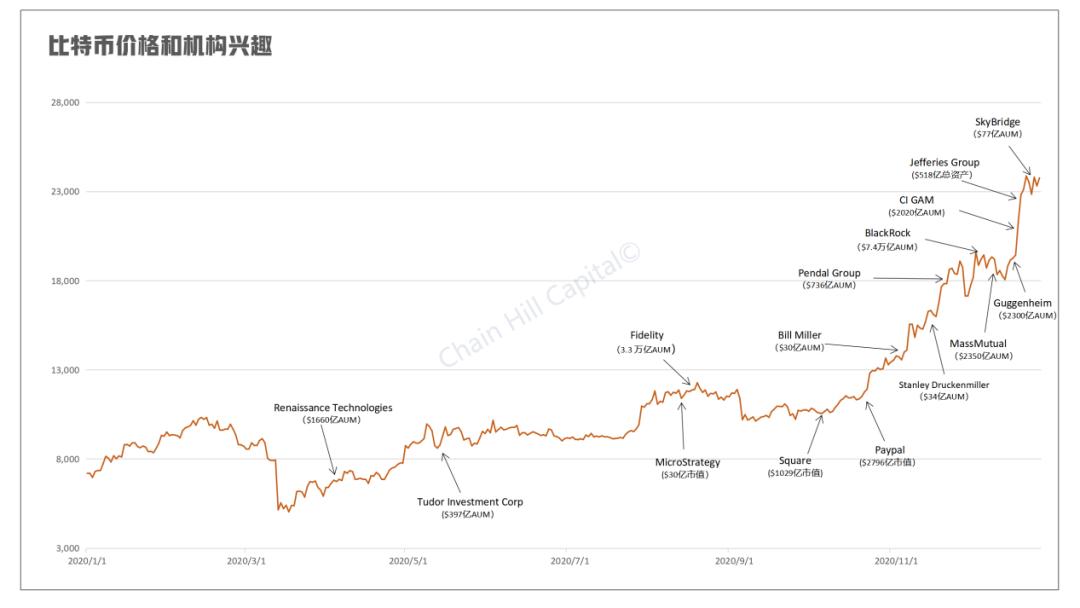 Image source: Chain Hill Capital
Image source: Chain Hill Capital
The above image shows significant events of traditional institutions entering the market in 2020. Since the famous hedge fund manager Paul Tudor Jones expressed important views on Bitcoin, the market has undergone tremendous changes. Starting in the second half of the year, the trend of institutional entry became increasingly evident, with institutional investors, including corporations, beginning to invest heavily in Bitcoin, directly driving the prosperity of the Bitcoin market in the second half of the year.
Following Paul’s judgment that Bitcoin is "the best investment opportunity in the era of great inflation," Larry Fink, CEO of the world's largest asset management company, also shared his thoughts on Bitcoin:
1) "Could it [Bitcoin] develop into a global market? -- Possibly."
2) "Will [Bitcoin] change the demand for the dollar as a reserve currency?"
For this institution, known for its conservatism, these comments are relatively rare. While this does not necessarily mean that BlackRock plans to invest in Bitcoin in the short term, it does indicate that the institution's leaders have been educating themselves and doing the necessary work.
These remarks also reveal an important message: Bitcoin has finally reached a stage where every financial institution feels the need to formulate a "Bitcoin strategy." These institutions may choose to do nothing, may choose to gain some exposure, or may take more significant measures. Although they will make different choices, at least the relevant discussions are happening within these institutions.
So far, various mainstream institutions have conveyed very positive views.

Image source: Chain Hill Capital
Public companies treating Bitcoin as a reserve asset is another significant event. Since MicroStrategy announced its purchase of Bitcoin in August, its stock price has risen by 125%. This could serve as a good demonstration. On one hand, as the purchasing power of the dollar continues to decline, more and more public companies may view cash reserves as an unsafe choice, thus converting some cash into digital currency. On the other hand, the wealth effect brought by MicroStrategy's purchase of Bitcoin may also attract some companies to adopt the same strategy. Therefore, the asset reserve demand of large enterprises may become a new institutional force.
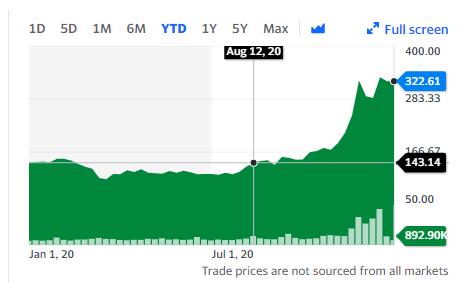
Image source: Yahoo
The significance of payment giant PayPal entering the market lies in opening a huge gateway to the retail market. According to estimates from Pantera Capital, the purchase volume on the PayPal platform has already exceeded 100% of the new Bitcoin supply. PayPal has eliminated the friction associated with investors buying and holding Bitcoin, and with over 345 million active users and 25 million merchants, this will greatly expand Bitcoin's user base (the estimated total number of users in the entire crypto market is about 100 million).
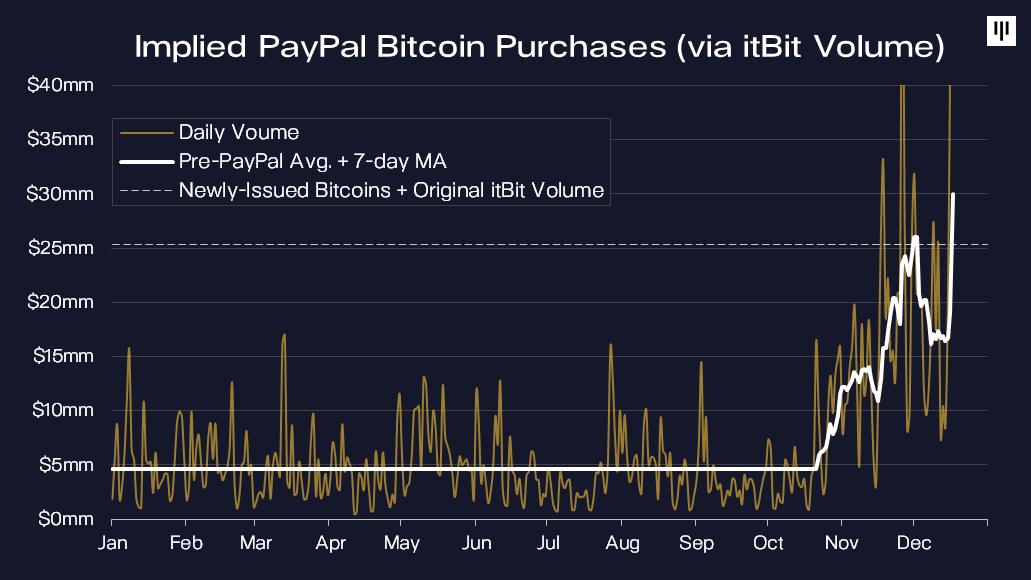
Image source: Pantera Capital
The main driving forces behind institutional entry can be categorized into several types:
1. Macro Hedging. In the current environment of low interest rates and expanding central bank balance sheets, the demand for hedging against fiat currency depreciation and inflation is continuously growing. As a result, Bitcoin has attracted macro investors like Paul Tudor Jones and Dan Tapiero, who seek the asset classes that benefit the most in the current environment; asset allocators like MicroStrategy and Square, who believe that fiat currency depreciation is inevitable and that Bitcoin is a sound currency that can replace fiat; additionally, the non-correlation investment attributes of cryptocurrencies have become more pronounced in the uncertain environment brought about by the pandemic.
2. Value Investing. These investors are optimistic about the long-term value of digital trends and cryptocurrency technology, viewing cryptocurrencies as a potentially asymmetric investment, believing that in the long term, cryptocurrencies like Bitcoin will replace gold and even change the global financial system.
3. Speculative Arbitrage. This includes various arbitrage and speculative activities. One of the most active arbitrage activities in the market this year has been the arbitrage of Grayscale trust products.
4. Strategic Layout. Visionary financial institutions like CI GAM, Pendal Group, Fidelity, S&P Dow Jones Indices, and technology companies like PayPal and Square have recognized the future needs of their clients and the development trends of crypto assets, preparing their layouts in advance.
We can see significant growth in institutional participation from various data points.
First, as more institutional investors join, the scale of the derivatives market aimed at institutional clients continues to expand. CME is currently one of the most accurate indicators of institutional interest. Since its launch in December 2017, the scale of CME Bitcoin futures has remained small, but since the second half of this year, the open interest in CME Bitcoin futures has continuously reached new highs, increasingly dominating the entire cryptocurrency futures market, reflecting the rising proportion of institutional investors.
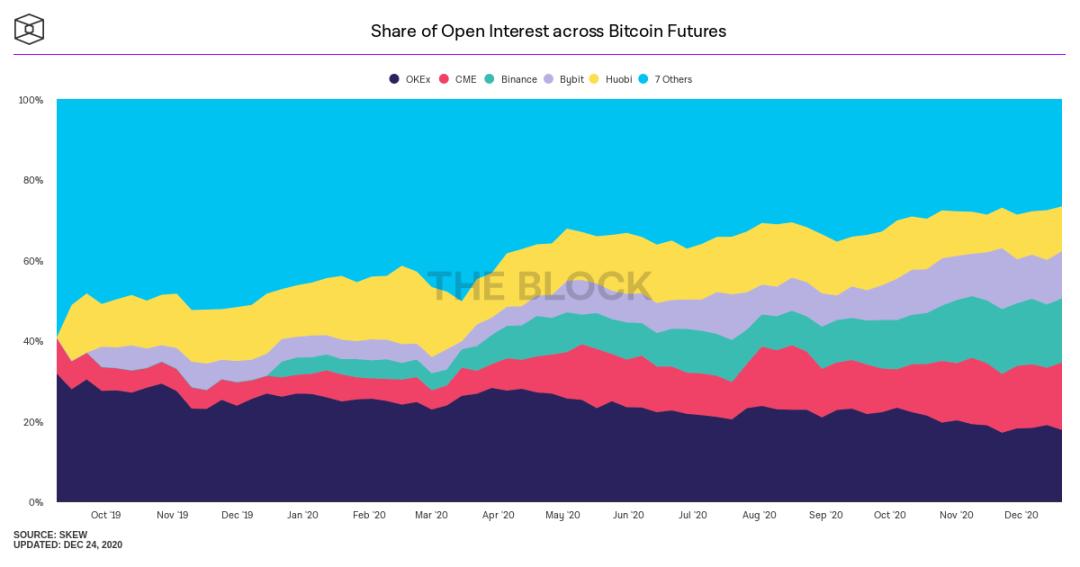
Image source: The Block
Secondly, as of December 25, the number of Bitcoin holdings disclosed by the bitcointreasuries website has reached 5.48% of the total Bitcoin supply. Although this 5.48% figure may not seem significant, it is worth noting that on October 21, this number was only 3.74%. This means that within two months, the proportion of Bitcoin held by the 28 institutional investors tracked by bitcointreasuries has increased by 1.74%, which corresponds to an annualized growth rate of 10%. If this growth rate continues, institutional investors could dominate the Bitcoin market in less than ten years. Moreover, this data does not represent the full picture of institutional holdings of Bitcoin.
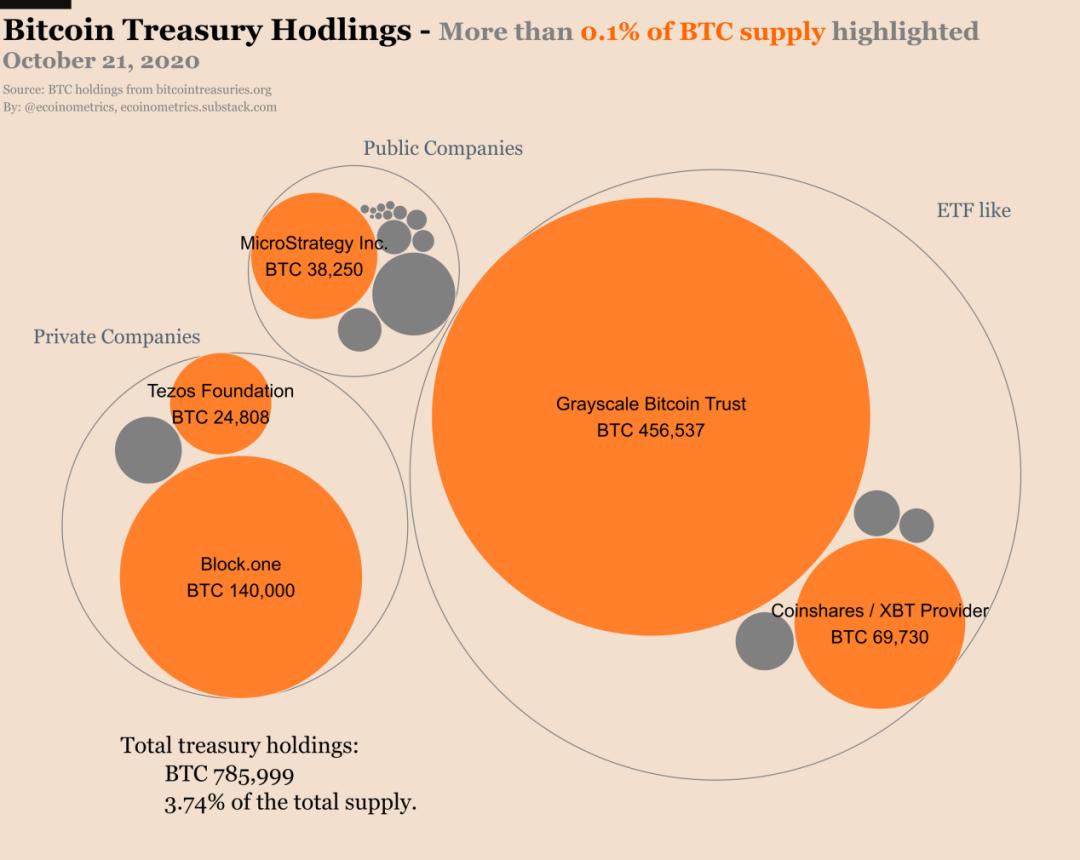
Image source: Ecoinmetrics
Additionally, the growth of assets under custody by custodial institutions also indicates increased institutional activity. The leading global custodian Coinbase revealed in November that they have seen a "capital explosion" from institutional investors, with their custodial assets reaching $20 billion, of which $14 billion has been new assets since April this year. Another major custodian, BitGo, announced on December 23 that its custodial assets have reached $16 billion, further validating institutional investors' interest in cryptocurrencies.
For a long time, the crypto market has been dominated by retail investors. With the entry of more professional investors and institutions, we may have reached a critical point. In the future, the influence of institutions on the Bitcoin market will grow, reshaping the structure of the Bitcoin market.
2. Future Trends
1. The "Grayscale Effect" will continue in the short term
Grayscale has created a trust structure for Bitcoin that allows for one-way inflows, effectively becoming a black hole for hoarding Bitcoin before it opens for redemptions. Grayscale's Bitcoin holdings have seen a qualitative leap this year, growing from 260,000 at the beginning of the year to over 600,000 now.
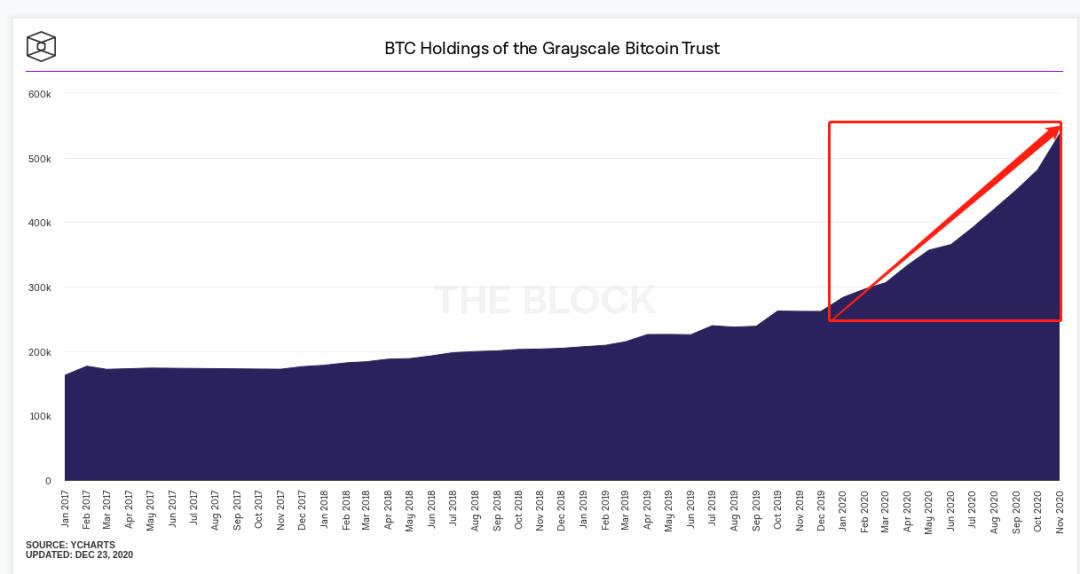
Image source: The Block
For institutional investors, Grayscale is a very useful arbitrage tool. Based on the current premium, they can achieve an annualized return of up to 60% (in Bitcoin terms) through arbitrage. These arbitrage institutions only need to adopt a very simple approach—use their held Bitcoin to subscribe for private placement shares, and then buy back spot Bitcoin during the share unlocking period to subscribe for shares, continuously repeating this process.
Buying back spot Bitcoin serves two purposes: one is to maintain their original Bitcoin holdings, and the other is to increase the premium of GBTC (as the premium usually follows the spot market). The higher the premium during the unlocking period, the more Bitcoin these institutions can buy back. They can then use these Bitcoins to start a new round of arbitrage.
By tracking the large-scale inflows into Grayscale Bitcoin Trust in the past, it can be observed that after each significant new share unlocking, the price of Bitcoin has shown a noticeable increase, and the premium rate of GBTC has also risen significantly. These phenomena have repeatedly occurred and are difficult to explain by coincidence; they are more likely the result of the aforementioned arbitrage behavior. Therefore, from this perspective, Grayscale is indeed an important driving force in the current market.
The following is a recent case demonstrating the Grayscale effect. According to Grayscale's Q3 report, the period from April 27 to June 29 was the fastest-growing period for Grayscale inflows this year. The corresponding unlocking period is from October 27 to December 29.
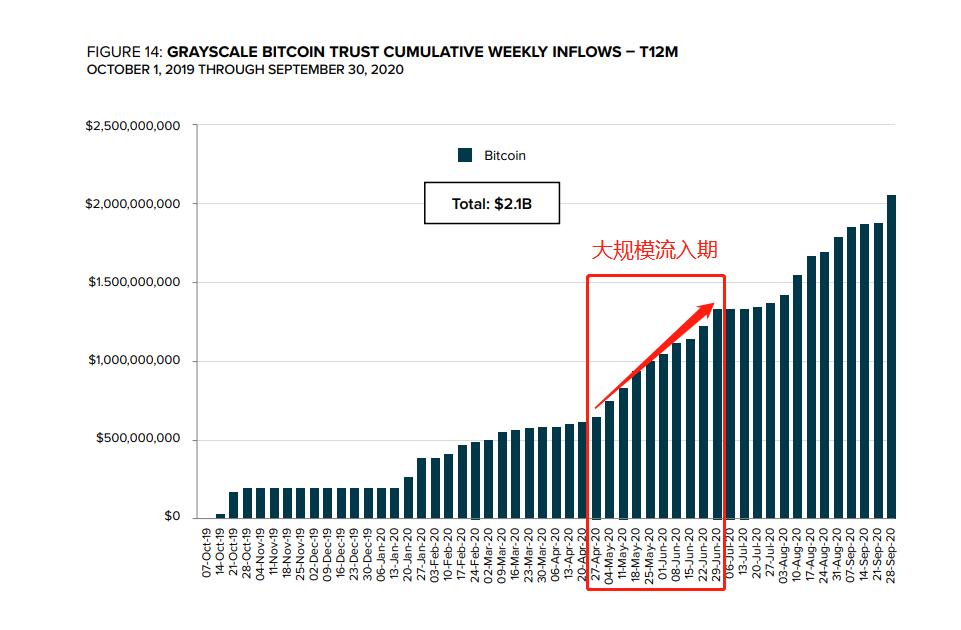
We can see that during this large-scale unlocking period starting from October 27, Bitcoin's growth has been very strong, and the contribution of the Grayscale effect is significant.
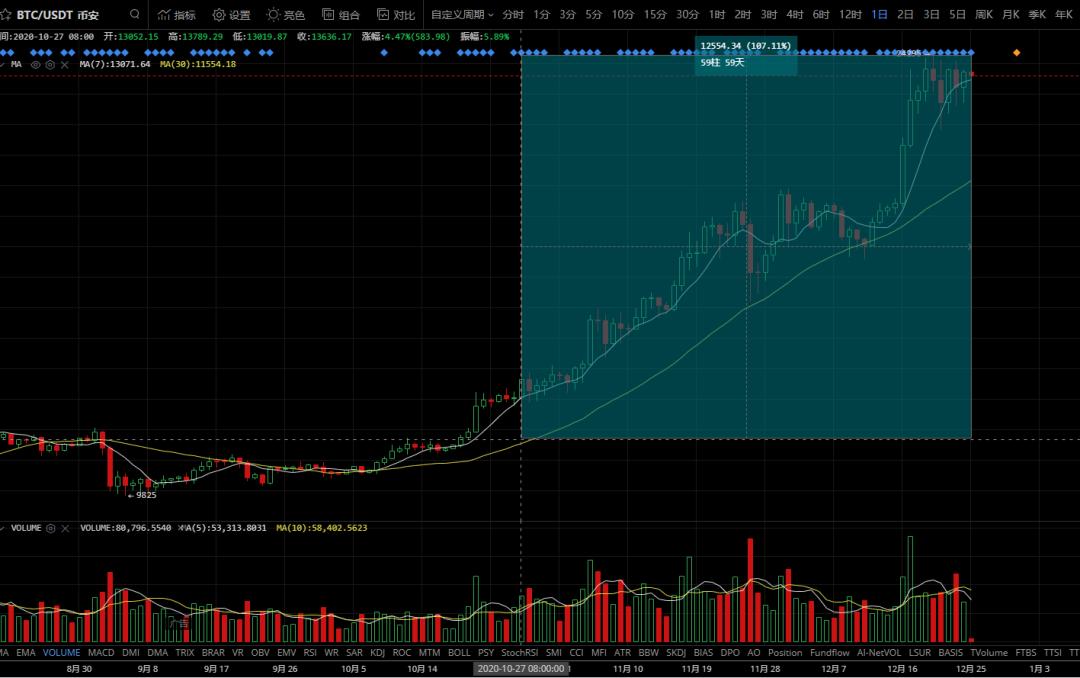
Image source: AIcoin
We can also find evidence in the GBTC premium; the premium rate after these large share unlockings has risen significantly compared to before the unlock.
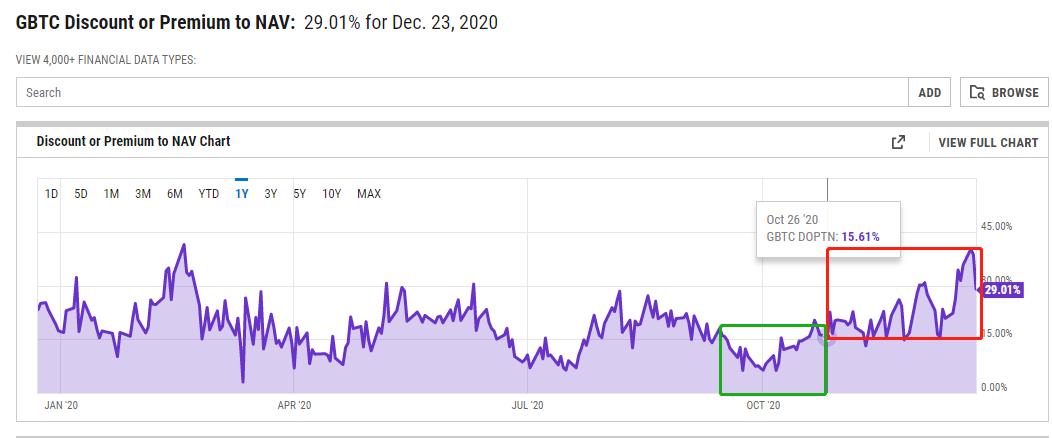
Image source: Ycharts
The "Grayscale Effect" is undoubtedly beneficial to the spot market for Bitcoin. Although this phenomenon is not sustainable in the long term, it will not disappear in the short term. There may even be more similar institutions emerging, enhancing this "Grayscale Effect." For example, recently, Bitwise's index fund has also started trading on the OTC markets, and the structure of this product is very similar to Grayscale—a non-redeemable quasi-ETF product.
On December 9, Bitwise announced that when it listed on OTCQX, its AUM was $115 million, and by December 25, its AUM had grown to $292 million. This nearly doubling in just over ten days indicates that more arbitrage capital has entered. Moreover, its premium rate is currently even higher than Grayscale's. If this high premium can be maintained, Bitwise will enhance the "Grayscale Effect."
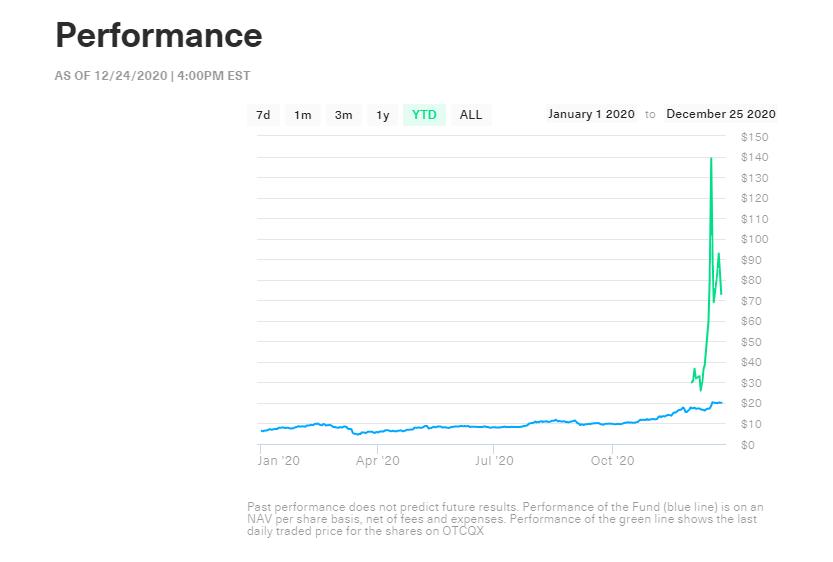
The "Grayscale Effect" may continue until regulatory intervention occurs, such as mandatory redemption openings or the SEC approving a Bitcoin ETF that causes securities like GBTC to lose competitiveness and demand.
2. Traditional Institutions Will Enter a Period of Rapid Growth
Traditional institutions did not just start entering this year; prior to this, mainly venture capital firms, family funds, and some hedge funds were involved.
This year, we have undoubtedly seen more mainstream institutions entering the market, including top hedge funds, large asset management companies, investment banks, insurance companies, and publicly traded companies. We are likely to enter a period of rapid growth for institutional entry. This is driven by multiple factors.
Sustained Macro Hedging Demand
Major global economies are at the end of a long-term debt cycle. The main characteristics of this period are high inflation rates and currency depreciation, and in this environment, inflation-hedging assets will continue to grow significantly.
Last week, the U.S. Congress passed a new $900 billion relief bill. This means that the U.S. is about to inject nearly $1 trillion into the economy, and the new government seems to have no intention of stopping liquidity injections after this relief package. The mainstream view is that the election of the Democrats means that there will be over $2 trillion in future relief (possibly even $3 trillion).
COVID-19 has undoubtedly exacerbated the already precarious debt cycle. The U.S. is trapped in an economy reliant on government intervention. It is estimated that since this summer, millions of Americans have fallen into poverty, and without relief legislation, these individuals would face dire circumstances. Therefore, whether through quantitative easing or interest rate manipulation, it will be difficult for the U.S. government to avoid intervening in the economy in the future. These government measures can alleviate short-term pain but will further undermine the dollar's status as the global reserve currency.
In July, cryptocurrency insurance company Evertas commissioned market research firm Pureprofile to interview 50 institutional investors, finding that 80% of institutional investors believe that the recent quantitative easing policies taken by central banks and governments in response to COVID-19 could lead to rising inflation rates, and that in the next five years, institutional investors will increasingly invest in Bitcoin to hedge against this situation and currency depreciation.
Traditional Investment Strategies Under Challenge
Low interest rates, and even negative interest rates on bonds, have increasingly called into question the traditional 40/60 asset allocation strategy. For the past thirty years, benchmark U.S. Treasury bonds have provided fixed, reliable yields, averaging 4%. Now, bond yields are continuously declining, with the annual yield on 10-year U.S. Treasury bonds at only 0.7%, and the scale of negative-yielding bonds globally has reached $30 trillion. Considering inflation, the real yield on bonds is even lower. These negative-yielding bonds will need to seek new alternatives.
Famous global macro investor Dan Tapiero pointed out that there are currently "190 trillion dollars of bonds and cash with real yields close to 0, and these assets have almost no hope of appreciation. The market value of gold investment is $2.6 trillion, while Bitcoin is $450 billion. The shortage of value reserve assets will lead to a rush for gold and Bitcoin. The fastest horse (Bitcoin) will become faster."
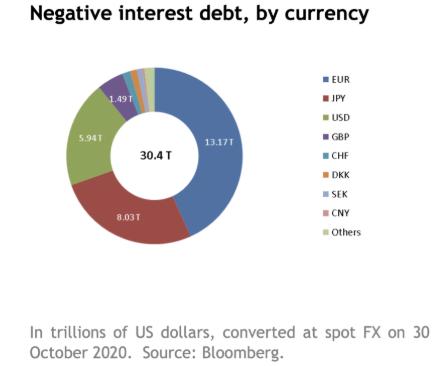
Image source: Bloomberg
Institutional "Herd Effect"
In 2017, Wall Street financial institutions described cryptocurrencies like Bitcoin as "tools serving criminals and drug dealers." Warren Buffett called it rat poison; his partner Charlie Munger said Bitcoin was like trading the brains of dead babies. Jamie Dimon of JPMorgan stated he would fire anyone trading Bitcoin.
Now, the narrative on Wall Street is rapidly changing. In October, JPMorgan released a report indicating that analysts believe Bitcoin's price could double or triple.
The 180-degree turnaround of JPMorgan is due to various reasons, including changes in the macro environment, PayPal's entry, and the reduction of career risk—because investors like Paul Tudor Jones have publicly expressed their optimism.
As more mainstream institutions express positive opinions, the winds are shifting. These institutions will lead the way and bring in a large number of followers. We will enter the next phase of institutional entry—where not having Bitcoin becomes risky. As this narrative gains popularity, we will see more capital flowing in.
As Anthony Scaramucci of SkyBridge stated, he sees "a large number of institutional investors" buying cryptocurrencies in 2021, indicating, "We may be witnessing a precursor to a massive influx of institutional investors."
3. Mainstream Institutions Propel Bitcoin to Become a Global Asset
The Mainstreaming of the "Digital Gold" Narrative Brings Positive Price Feedback Loops
Narratives are powerful machines that can drive outcomes. When all investors begin to believe in a narrative, it will change the flow of capital and ultimately "self-fulfill." Now, institutions and mainstream media are increasingly discussing the story of Bitcoin as "digital gold" and an alternative asset, and this narrative will continue to strengthen, leading to positive feedback loops.
As some institutions begin to believe that Bitcoin is "digital gold," they will bring in more capital, leading to the price increases we currently see. As prices rise, it will attract more institutional attention, resulting in increased demand, further driving price increases and reinforcing the narrative.
Institutional investors will provide a huge source of demand for Bitcoin. Unlike retail investors, mainstream institutions are long-term players, so this positive price feedback loop will last longer and be more robust. This situation will continue until real FOMO triggers a market collapse.
Institutions Become the Bridge for Bitcoin to Reach the Mass Market
In the technology lifecycle, a new technology faces a gap between early markets and mass markets, and mainstream institutions will become the bridge for Bitcoin to cross this gap. Currently, the user and cognitive thresholds for cryptocurrencies are relatively high, lacking comprehensive and convenient solutions for purchasing, using, storing, and compliance. Institutions can fill this gap by providing complete solutions. We will see more financial advisors offering cryptocurrency-related investment advice to clients, more financial institutions providing cryptocurrency investment tools (such as mutual funds and ETFs) in ways familiar to investors, and federally chartered banks in the U.S. beginning to offer custodial services for crypto assets, while platforms like PayPal will continue to improve access to cryptocurrencies. Based on their existing customer base, these institutions can bring Bitcoin to a broad mainstream audience.

In summary—traditional asset management institutions manage nearly $100 trillion in assets, and their entry will bring significant incremental funds to cryptocurrencies. As market capitalization grows, the crypto market will become more mature, and price volatility will gradually decrease. All of this will lay the foundation for Bitcoin to become a global asset.









